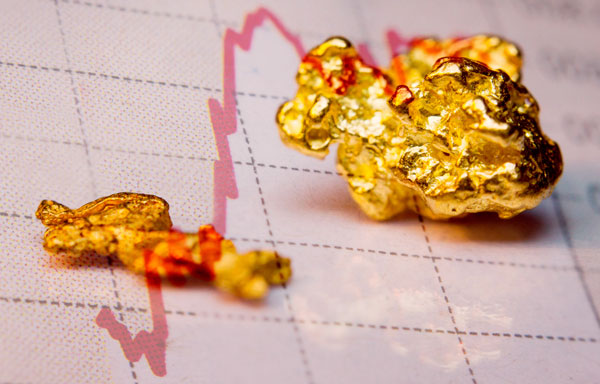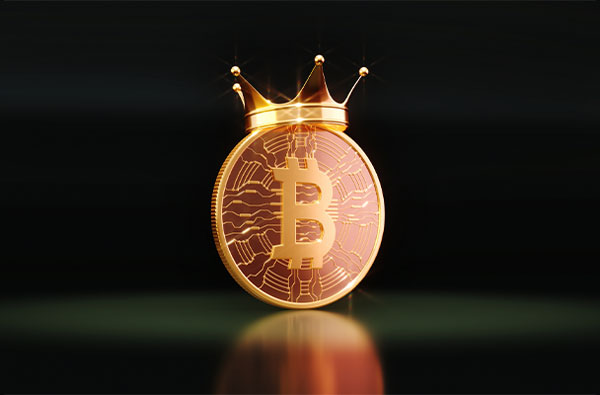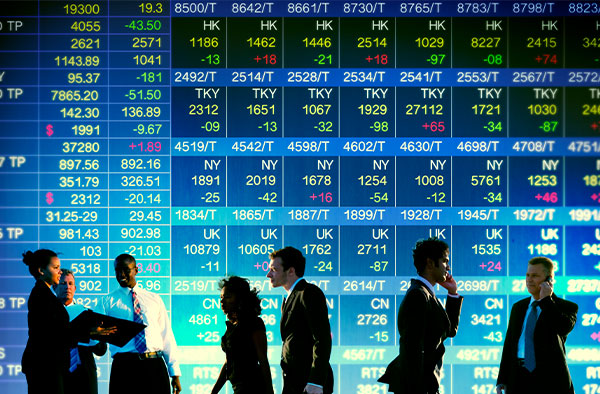
This Could Be the “Perfect Storm” that Pushes Gold to a New Record High
A "perfect storm" of surging government debt levels, plunging real bond yields, rising coronavirus cases and deteriorating economic forecasts pushed the price of gold to an eight-year high this week, and some analysts now project the metal to top its all-time high within the next 12 months.
This Could Be the “Perfect Storm” that Pushes Gold to a New Record High
By Frank Holmes
CEO and Chief Investment Officer
U.S. Global Investors

A “perfect storm” of surging government debt levels, plunging real bond yields, rising coronavirus cases and deteriorating economic forecasts pushed the price of gold to an eight-year high this week, and some analysts now project the metal to top its all-time high within the next 12 months.
Gold touched $1,778 an ounce on Wednesday, its highest level since February 2012 and coming within striking distance of the psychologically important $1,800 resistance level.
What drove the yellow metal’s price action this week was not just an alarming rise in confirmed virus infections—U.S. cases hit a new single-day record of more than 40,000 on Thursday—but also a weakening U.S. dollar. The greenback declined the most in three weeks as the yen and euro strengthened amid gains in global shares.
Looking more long term, gold continues to find support from negative yields, both real and nominal. The amount of negative-yielding government bonds around the world rose back above $13 trillion this week for the first time since March. The high of $18 trillion was set in August of last year.
The real 10-year Treasury yield traded as low as negative 0.66 percent on Tuesday, a level we haven’t seen since May 2013. As I’ve shown a number of times before, gold trades inversely to bond yields, and when they turn negative, it’s like rocket fuel for the yellow metal.
IMF Lowers Its 2020 Economic Growth Forecast. More Money-Printing Ahead?
Meanwhile, the International Monetary Fund (IMF) lowered its economic growth forecast for 2020. The world economy is now projected to plunge nearly 5 percent this year, a downward adjustment of 1.9 percentage points from the IMF’s April forecast.
“The COVID-19 pandemic has had a more negative impact on activity in the first half of 2020 than anticipated, and the recovery is projected to be more gradual than previously forecast,” IMF economists wrote in the June 24 report.
This could spur even more monetary and fiscal stimulus from world central banks and governments, which is already unprecedented. The Bank of England (BoE) recently added to its bond-buying program, and the Federal Reserve has signaled that it will be keeping rates near zero.
|
|
Get this: As of right now, the Fed’s balance sheet stands at $7 trillion, or 33 percent of U.S. GDP. And earlier this month, the Treasury’s public debt soared past $26 trillion, an incredible 120 percent of the entire U.S. economy.
This isn’t sustainable, obviously, and some analysts now see dollar-denominated gold hitting a new all-time high in the next 12 months, even in a risk-on environment. Both Morgan Stanley and Citigroup maintain their call for $2,000 gold by mid-2021.
London-based research firm Edison goes even further. In a note dated June 23, analysts there commented that gold should be near $1,900, “with the potential for this to rise to in excess of $3,000.”
Gold’s Best Year Ever (So Far) in Dollar Terms
So far in 2020, physical gold is comfortably the best performing major asset. It’s outperformed not just the S&P 500 but also the U.S. dollar, emerging markets, Treasuries and high-yield corporate bonds.
In fact, this is gold’s best year ever so far in dollar terms. The chart below shows you all the highest highs (the red line) and lowest lows (teal line) between January and December from the past 10 years. The yellow line is gold’s price action in 2020, and as you can see, it’s trading higher at this point than it ever has in the month of June.
Historically, June has been a relatively weak month for gold, making it a good time to consider adding the metal to your portfolio in anticipation of seasonal asset appreciation. India, the world’s second largest purchaser of gold after China, has two big events coming up that in years past have pushed the metal’s price higher thanks to increased demand. I’m talking, of course, about Diwali and the Indian wedding season, both of which I’ve written and spoken about numerous times.
The question this year, though, is how much of an impact the pandemic will have on these huge cultural celebrations, and if gold will see a difference.
Will COVID-19 Derail the $50 Billion Indian Wedding Season?
Like the U.S., India just had its biggest one-day spike in new coronavirus cases, with approximately 17,000 reported on Thursday. The Asian country is the fourth worst affected country after the U.S., Brazil and Russia, and its death toll is the eighth worst.
Again, gold demand in anticipation of the upcoming Diwali celebration and Indian wedding season has helped prices move higher heading into August and September. Were this a “normal,” non-pandemic year, the added demand may have been such that gold could top $1,800 an ounce or more.
There are already reports of some Indian couples delaying or outright cancelling their 2020 wedding plans, not just as a precautionary measure but also to wait it out and tie the knot under more ideal conditions. Indian weddings have traditionally been grand affairs attended by large numbers of family members, a clear health risk in the age of COVID-19.
For couples who are choosing to move forward with wedding plans, there’s a new “essential”: matching face masks.
As a result of the cancellations, gold consumption in India could potentially fall as much as 50 percent in 2020 compared to last year, from 690.4 metric tons in 2019 to between 350 and 400 tons this year, according to one forecast.
Although this may end up being the case, it’s worth remembering that gold still plays a massive role in many other corners of Indian culture. Indians still save in gold, with as much as 75 percent of Indian savings invested in the precious metal, according to Incrementum. Private households in the country are estimated to be the single largest gold hoarders in the world, with some 24,000 metric tons. That’s more than three times the amount the U.S. has in reserves.
There could also be some good news thanks to a healthy monsoon season, which begins this month and continues through September. It’s been estimated that a third of Indian gold demand comes from rural farmers, whose crop revenue depends on the rains delivered by a good monsoon.
This year the monsoon is forecast to be normal, and already Indian sugar producers are having an excellent season, with exports at a record volume for the second year in a row. I believe this is constructive for gold demand.
Fore more on gold’s seasonality, watch my video on buying the dips by clicking here.
Royalty Companies a Smart Way to Play the Gold Rally
When it comes to getting exposure to gold, my favorite way continues to be royalty and streaming companies. Industry leaders Franco-Nevada and Wheaton Precious Metals have soared over the past 12 months, with Franco up 63.6 percent through today, Wheaton up 71.6 percent.
I’m not the only one who likes these companies, though. Ray Dalio, the billionaire hedge fund manager of Bridgewater (the largest hedge fund in the world), is a big gold bug. According to Bridgewater filings for the March quarter, SPDR Gold Shares (GLD), which invests in physical gold, stood as Dalio’s second largest holding, valued at more than $600 million.
Included in his holdings are the three companies in the chart above, Franco, Wheaton and Royal Gold, with a combined value of $12.6 million. Go gold!
Mark Your Calendars!
Speaking of gold royalties, I will be participating in an upcoming webinar called “Maximizing returns and minimizing risk investing in Gold Royalties.” The webinar will be held on Monday, June 29, between 1:00 and 2:00pm Pacific time. I’ll be joined by Joe Mazumdar, editor and analyst at Exploration Insights. I hope you’ll join us! To register for this event, click here.
Gold Market
This week spot gold closed at $1,771.29, up $27.42 per ounce, or 1.57 percent. Gold stocks, as measured by the NYSE Arca Gold Miners Index, ended the week higher by 5.15 percent. The S&P/TSX Venture Index came in up 5.56 percent. The U.S. Trade-Weighted Dollar fell 0.13 percent.
| Date | Event | Survey | Actual | Prior |
|---|---|---|---|---|
| Jun-23 | New Home Sales | 640k | 676k | 580k |
| Jun-25 | Durable Goods Orders | 10.5% | 15.8% | -18.1% |
| Jun-25 | GDP Annualized QoQ | -5.0% | -5.0% | -5.0% |
| Jun-25 | Initial Jobless Claims | 1320k | 1480k | 1540k |
| Jun-29 | Hong Kong Exports YoY | -5.2% | — | -3.7% |
| Jun-29 | Germany CPI YoY | 0.6% | — | 0.6% |
| Jun-30 | Eurozone Core CPI YoY | 0.8% | — | 0.9% |
| Jun-30 | Conf. Board Consumer Confidence | 90.0 | — | 86.6 |
| Jun-30 | Caixin China PMI Mfg | 50.7 | — | 50.7 |
| Jul-1 | ADP Employment Change | 3000k | — | -2760k |
| Jul-1 | ISM Manufacturing | 49.0 | — | 43.1 |
| Jul-2 | Change on Nonfarm Payrolls | 3000k | — | 2509k |
| Jul-2 | Initial Jobless Claims | 1350k | — | 1480k |
| Jul-2 | Durable Goods Orders | — | — | 15.8% |
Strengths
- The best performing precious metal for the week was gold, up 1.57 percent. Gold is heading toward $1,800 an ounce driven by fear that the resurgence in virus cases will impede the global economic recovery. Gold for August delivery rose to $1,796.10 on the Comex on Monday – the highest level since 2012. The yellow metal saw a third straight weekly gain, which is its longest winning streak since January. According to Bloomberg data, gold-backed ETFs saw a fourteenth week of net inflows.
- The Union of Gold Producers of Russia said in a statement this week that Russian gold output in the first quarter rose more than 5 percent to 64.6 tons from a year earlier. The increase was due to a ramp up in production by smaller miners.
- Bloomberg’s Eddie van der Walt is very bullish on gold. “A mix of slow growth, easy money and black swans can propel gold to record highs in the second half of 2020.” Gold is one of the best performing major assets in the past year and has soared by a quarter.
Weaknesses
- The worst performing precious metal for the week was palladium, down 1.57 percent on the net-long position of palladium futures dropping to a three-week low. Perhaps the move came on speculation that automobile sales could contract short-term with virus outbreaks in the U.S. beginning to dominate headlines. After rising to nearly $1,800 an ounce early this week, gold struggled to hold onto its gains. U.S. inflation rose higher-than-expected on Friday. The core personal consumption expenditures index rose 0.1 percent in May, up from the 0.4 percent decline in April.
- Barrick Niugini, the operators of the Porgera gold mine in Papua New Guinea said in a statement that most of its 2,650 workforce will be retrenched in the coming weeks. The mine was put on care-and-maintenance after the government decided not to extend its special lease. Bloomberg notes the mine is a joint venture between Barrick and Zijin Mining.
- The U.S. dollar rose on Friday as investors look for safe havens amid troubling news that coronavirus cases are surging in America. There are also doubts that a V-shaped economic recovery is far from possible. Gold and the dollar don’t often move in the same direction, and a rise in the dollar could mean a fall for gold.
Opportunities
- Roxgold announced that its drill program at the Seguela project returned 20 meters at 28 grams per ton of gold. Tanzanian Gold Corp was up 6.3 percent in U.S. pre-market trading on Wednesday due to an increase in resources at its Buckreef gold project in Tanzania. Alexco Resource Corp announced that it is moving forward with the final development of its mines at Keno Hill and amended its silver purchase streaming agreement with Wheaton Precious Metals.
- RBC said it remains constructive on gold mining stocks. The bank upgraded Centamin Plc to outperform and have kept Polymetal and AngloGold both at outperform. Analysts led by James Bell wrote that the macro backdrop for gold remains supportive at a time when companies have been conservative in their outlooks.
- Harmony Gold Mining, South Africa’s top gold miner, raised $200 million through a share sale after investors backed its plan to purchase AngloGold Ashanti’s last South African operations, reports Bloomberg. CEO Peter Steenkamp said, “the successful placement is a validation of our investors’ support for Harmony’s stated strategy to safely grow quality ounces and increase margins.”
Threats
- Capital Economics is sticking to its somewhat bearish outlook for gold. The firm projects the yellow metal to ease back for the rest of 2020 due to weak physical demand out of Asia, reports Kitco News. Chief commodities economist at Capital Economics Caroline Bain said, “although ultra-low real yields and a somewhat weaker U.S. dollar will keep the gold price elevated, safe-haven demand will be more subdued as economic activity picks up.”
- Coronavirus cases are spiking globally, especially in the U.S. and Latin America. Chile, a top miner, has now seen nearly 260,000 cases. This could lead to mining operations being shut down again and slowing production, particularly for copper.
- According to Black Knight Inc., the number of home-mortgages more than 30 days late rose to 4.3 million in May, up from 723,000 in April. More than 8 percent of all U.S. mortgages were past due or in foreclose last month, notes Bloomberg. This is a staggering sign of the economic downturn inflicted by the pandemic.
Index Summary
- The major market indices finished down this week. The Dow Jones Industrial Average lost 3.31 percent. The S&P 500 Stock Index fell 2.86 percent, while the Nasdaq Composite fell 1.90 percent. The Russell 2000 small capitalization index lost 2.81 percent this week.
- The Hang Seng Composite lost 0.23 percent this week; while Taiwan was up 0.96 percent and the KOSPI fell 0.31 percent.
- The 10-year Treasury bond yield fell 5 basis points to 0.641 percent.
Domestic Equity Market
Strengths
- Information technology was the best performing sector of the week, decreasing by 0.45 percent versus an overall decrease of 2.86 percent for the S&P 500.
- Gap Inc was the best performing S&P 500 stock for the week, increasing 13.23 percent.
- Accenture jumped as much as 8 percent, with shares hitting an intraday record after the company posted third-quarter results that beat expectations. “Positive bookings growth of 6 percent stands out despite COVID-19 uncertainty,” wrote Cowen, which reiterated its outperform rating and $210 price target.
Weaknesses
- Energy was the worst performing sector for the week, decreasing by 6.44 percent versus an overall decrease of 2.86 percent for the S&P 500.
- American Airlines Group Inc was the worst performing S&P 500 stock for the week, falling 22.62 percent.
- Wirecard filed for insolvency after a devastating scandal that saw $2 billion go missing and its ex-CEO arrested. The company’s shares dove 75 percent on the news of insolvency.
Opportunities
- Tech-driven insurance startup Lemonade Inc said on Thursday it was looking to raise up to $286 million in its IPO.
- Singapore telecoms operators selected Nokia and Ericsson to build 5G networks. The companies said they were also exploring other network partners with China’s Huawei and ZTE.
- Volkswagen sees a V-shaped recovery lasting into 2022 as businesses try to work out how quickly they will rebound from the coronavirus pandemic.
Threats
- Famed investor Wolf Richter says he’s shorting stocks because they’re more overpriced than before the dot-com crash. Richter is shorting the SPDR S&P 500 ETF because he’s wary of the day-trading boom and the record stock-market rally given the weak U.S. economy.
- Brands including The North Face, REI and Talkspace have halted their paid advertising on Facebook after a boycott campaign led by civil rights groups. Facebook has come under fire for refusing to moderate posts by President Trump that threatened Black Lives Matters protesters with violence. Further, Verizon was the latest company to join the boycott, making it the biggest advertiser to do so thus far, CNBC reports.
- Day trading for fun is a ‘losing proposition,’ Princeton economist and author Burton Malkiel warns. Many of the people who have taken up day trading during the pandemic are substituting stock picking for sports betting and will almost certainly lose money, Wealthfront’s investment chief Burton Malkiel said in a recent MarketWatch interview.
The Economy and Bond Market
Strengths
- Orders for durable goods such as automobiles surged in May after historic declines in the early spring when the U.S. was locked down. However, manufacturers may struggle to make a more rapid recovery amid a fresh outbreak of the coronavirus along with a depressed global economy. Orders jumped 15.8 percent last month, the government said Thursday.
- Consumers in the U.S. increased their spending by 8.2 percent in May, the Associated Press reports, partly erasing record plunges the previous two months.
- The flash U.S. service sector purchasing managers index (PMI) rose to a four-month high of 46.7 in June from 37.5 in the previous month, IHS Markit said Tuesday. The flash manufacturing PMI rose to a four-month high of 49.6 from 39.8 in May, MarketWatch reports. Though an improvement, the readings remain slightly below the 50 mark.
Weaknesses
- The Covid-19 pandemic is tearing through the U.S. heartland, writes Bloomberg this week, setting records for hospitalizations and forcing businesses to rethink their plans to reopen as new modeling predicts the virus will kill 180,000 Americans by October. With the U.S. seeing one of its highest-ever increases in cases Wednesday, some states took drastic measures, imposing face mask orders and internal quarantines.
- The number of Americans seeking unemployment benefits was higher than forecast for a second straight week, reports Bloomberg, adding to signs that the recovery is cooling amid a pickup in coronavirus cases. Initial jobless claims fell to 1.48 million in the week ended June 20 from an upwardly revised 1.54 million in the prior week, Labor Department figures showed Thursday.
- Friday’s Commerce Department report showed a 4.2 percent decline in personal income, which had soared by 10.8 percent the previous month. Income had jumped in April on the strength of billions of dollars in support through government payments in the form of unemployment aid as well as one-time $1,200 stimulus checks.
Opportunities
- The Fed will be making some headlines next week as Chairman Jerome Powell faces questions in Congress on Tuesday about the central bank’s pandemic response and the minutes of the June Federal Open Market Committee (FOMC) meeting are published on Wednesday.
- Europe’s economy continued to bounce back from the worst impacts of the coronavirus pandemic in June, according to IHS Markit’s PMI surveys. The readings showed a figure of 47.5, up from around 32 in May, meaning that while the eurozone economy is still shrinking, it is doing so at a much slower rate than before.
- The municipal-bond analysts at Barclays say the lesson of the last recession shouldn’t be lost in the current one. A decade ago, despite speculation that the deep financial hit from the housing-market crash would cause widespread bond defaults by states and cities, they remained rare as governments slashed spending and raised taxes to cover the shortfalls in their budgets. With governments now being hit by a surge in unemployment and business closures, Barclays analysts said they don’t expect the outcome will be different this time. Municipal analysts expect defaults to be largely limited to the lower-rated securities sold by government agencies on behalf of hospitals, nursing homes and industrial projects, a relatively small share of the $3.9 trillion market. Only a handful of local governments went bankrupt after the last recession and no state has defaulted on its bonds since Arkansas did in the wake of the Great Depression.
Threats
- Next week the American labor market is projected to have added another 3 million jobs in June on top of May’s 2.5 million. That would still leave the unemployment rate at a staggering 12.2 percent.
- The nation’s economic recovery from the coronavirus recession could stall if Congress fails to provide substantial federal aid to local governments, the National League of Cities said Tuesday. Citing a survey of 1,100 municipalities, the league said 65 percent have been forced to delay or cancel infrastructure projects and capital expenditures because of the pandemic’s toll on local government finances.
- The U.S. could put tariffs on $3.1 billion of European goods, with products like olives, beer, gin and planes on the list, according to a Tuesday note by the U.S. Trade Representative.
Energy and Natural Resources Market
Strengths
- The best performing commodity for the week was lumber, up 2.61 percent on robust demand for home improvement projects. Investments in U.S.-listed commodity ETFs rose nearly 10-fold last week for the 14th straight week of inflows. Bloomberg data shows that precious metals ETFs led the inflows with $2.04 billion and energy ETFs had the second biggest change from the previous week.
- Copper rose to around $6,000 a tonne, a five-month high, as supply disruptions out of Latin America outweighed demand concerns. Bloomberg notes this is a sixth weekly gain for the metal. Morgan Stanley said that copper is its most-favored industrial commodity over the next six months.
- Physical crude oil prices in Europe are rising thanks to Russia’s massive output cuts. Derivatives contracts for Russia’s flagship grade rose to a premium of more than $2 a barrel to the Dated Brent benchmark last week, compared with a discount of $4.50 in April, reports Bloomberg. Eugene Lindell, senior analyst at JBC Energy GmbH, said “the market looks to be in full recovery mode.”
Weaknesses
- The worst performing commodity for the week was natural gas, down 10.43. Natural gas futures in the U.S. continued to fall after closing at the lowest settlement in nearly 25 years. Bloomberg reports that gas prices fell on Thursday after government data showed the largest stockpile gain for the month of June since 2003. Virus lockdowns are curbing consumption of the fuel. The front-month contract on the New York Mercantile Exchange dropped 7.2 percent to $1.482 on Thursday, the lowest settlement since August 1995.
- Industrial metals including copper and zinc fell on Tuesday as investors turned cautious on the prospects for an economic revival as the U.S. sees a surge in COVID-19 cases, reports Bloomberg. All metals except lead moved lower in London.
- Oil had a second weekly decline as the surge in U.S. coronavirus cases hurt the demand outlook for fuel. Saudi Arabia’s revenue from oil exports is plunging despite major output cuts. The major oil producer saw its earnings from crude fall 65 percent from a year earlier even as prices have risen nearly 60 percent since the beginning of May to around $40 a barrel. Recently, they indicated they would borrow more money to pay the dividend for Aramco.
Opportunities
- Hydrogen could meet nearly half of the U.K.’s energy demand by 2050, according to a report by Aurora Energy Research. The U.K. has set a target for zero emissions by 2050 and using hydrogen in industrial processes would take demand off the electricity system. BloombergNEF notes that the world currently produces 110 million tons of hydrogen annually and major obstacles are still in place for the clean fuel to replace fossil fuels in any sector.
- BMO Commodities Research noted this week that China’s auto sector could be a big boost for platinum demand through 2021. Chinese auto output rose 50 percent year-over-year in the first 20 days of June. Although passenger vehicles sales were down 27 percent year-over-year in May, BMO sees potential upside to commercial vehicle sales. China’s government has encouraged local governments to spend and phase old trucks and adopt newer models.
- BloombergNEF’s Long-Term Electric Vehicle Outlook predicts that electric vehicle sales will experience a smaller dip than traditional auto sales due to the economic squeeze from COVID-19. They also predict that sales will bounce back faster once the market recovers and that infrastructure spending will ramp up. Germany just announced that it has included EV chargers in its 2.5 billion euro proposed economic package. The EU is aiming to have 1 million public chargers by 2025, up from just 200,000 today.
Threats
- Germany is preparing to strike back if President Trump acts on his threat to intervene in the Nord Stream 2 gas pipeline. Chancellor Merkel is considering pressing for EU action against the U.S. The U.S announced potential tariffs on $3.1 billion of productions from Germany and other European countries, just as the EU is debating whether to maintain a ban on American travelers due to the spread of COVID-19. The Nord Stream pipeline under the Baltic Sea is designed to pump Russian gas to Germany and has created divisions among EU member states.
- The U.S. shale recovery could take years after decades of excess spending and production. There are now just 189 active drill rigs, a 72 percent drop since March and the lowest since 2009 when shale had just begun. Bloomberg notes that evidence of the negative outlook for producers can be seen in their spending plans, which are down by almost half to about $54 billion this year. According to Deloitte, almost a third of U.S. shale producers are technically insolvent with crude oil at $35 a barrel. The threat is that oil could remain this low for much longer.
- The Trump Administration is taking aim at ESG funds, even as one in four of every professionally invested U.S. dollar is tied to environmental, social and governance criteria. The Labor Department said that it would require those overseeing pension and 401k plans to always put economic interests ahead of “non-pecuniary” goals. “After years of the Department of Labor having varying degrees of guidelines about if you can consider ESG factors, they are coming out definitively to say it’s not appropriate to consider,” said attorney Josh Lichtenstein, a partner in Ropes & Gray’s ERISA practice.
June 25, 2020Ralph Aldis’ Outlook on Gold and Resource Companies |
June 15, 2020Is the Fed or COVID-19 Moving Markets? |
June 4, 2020U.S. Global Investors Announces its Airline ETF Crossed Above $1 Billion in Assets |
|||
Emerging Europe
Strengths
- Turkey was the best performing country this week, gaining 90 basis points. Turkish equites rose as foreigners are buying for a second week. Home sales jumped amid record low mortgage rates. Turkey surprised with no rate cut for the first time in a year. Karsan Otomotive, a light commercial trucks and vans maker, was the best performing equity trading on the Istanbul Stock Exchange, gaining 18.5 percent over the past five days.
- The Polish zloty was the best performing currency this week, gaining 45 basis points. Andrzej Duda, the President of Poland, met with U.S. President Donald Trump this week in the White House, just days before the scheduled Presidential election on Sunday. The United States may relocate some troops from Germany into Poland.
- Consumer staples was the best performing sector among eastern European markets this week.
Weaknesses
- Hungary was the worst performing country this week, losing 2.3 percent. Current account balance was reported much weaker in the first quarter and the Central Bank surprised investors with its first rate cut since 2016. 4IG, a software development company, was the worst performing stock trading on the Budapest Stock Exchange, losing 10 percent over the past five days.
- The Hungarian forint was the worst performing currency in the region this week, losing 2.4 percent. The Central Bank unexpectedly cut its main rate by 15 basis points for 75 basis points and indicated that another cut might follow in July.
- Health care was the worst performing sector among eastern European markets this week.
Opportunities
- The flash eurozone composite purchasing managers index rose to a four-month high of 47.5 in June, from 31.9 in May, though the figure was still below the 50-mark indicating deteriorating conditions. It did beat the 43.0 forecasted by Bloomberg. The services PMI rose to 47.3 from 30.5 in May, and the manufacturing PMI rose to 46.9 from 39.4 in May, which both were four-month highs. "Output and demand are still falling but no longer collapsing," said Chris Williamson, chief business economist at IHS Markit.
- According to Mirae Asset Management, Brazil, Peru and Russia are well positioned to lead the gains among emerging peers and even beating developed peers. In Russia, companies with strong balance sheets stand to benefit as oil demand and prices recover in the second half of the year. South Africa and Turkey, in the meantime, face political and structural challenges.
- Poland will hold presidential elections on Sunday. Andrzej Duda is running for re-elections and the race is not certain. Duda is leading in polls but Rafal Trzaskowski, mayor of Warsaw who recently joined the race is not too far behind and his approval is growing. First round of elections are scheduled June 28, and the second round will take place July 12.
Threats
- Verkhoyansk, a Siberian town in Russia, reached 100.4 degrees Fahrenheit last Saturday, breaking the record high temperature for the region. Warmer weather may present future problems for Russian operating assets sitting on the permafrost. About 70 percent of Russia is technically classified as permafrost, but a majority is not an issue since it is ground/soil that is frozen, says Ildar Davletshin from Wood & Company. However, some operations in Russia are set on frozen mud and rising temperatures may create problems.
- The MSCI announced it is considering whether to launch a consultation on a reclassification proposal for the MSCI Turkey Index to Frontier Markets or Standalone Markets status “if the already deteriorating accessibility level of the Turkish equity market were to worsen further.” The group said the accessibility level of the Turkish equity market had been “adversely impacted” by the introduction of short-selling and stock lending bans in October 2019 and February 2020, respectively.
- Bloomberg reports the Trump administration is weighing new tariffs on $3.1 billion of exports from France, Germany, Spain and the U.K., adding to an arsenal of measures it is using against the EU that could spiral into a wider transatlantic trade fight later this summer. New tariffs on European exports could include olives, beer, gin and trucks, while increasing duties on products including aircrafts, cheese and yogurt, according to a notice published late Tuesday evening.
China Region
Strengths
- India was the best performing country this week, gaining 1.3 percent. For the second week in a row, Indian equites outperformed their regional peers on reopening optimism. The nation had started reopening even as it counts the fourth-highest number of coronavirus infections in the world. Hero MotorCorp., maker and distributor of motorcycles, was the best performing equity among stocks trading on the NSE Nifty 50 Index, gaining 7.8 percent over the past five days.
- The South Korean won was the best performing currency this week, gaining 85 basis points. The currency rose as tensions on the Korean Peninsula eased. North Korean leader Kim Jong Un suspended military actions against South Korea on Wednesday after blowing up a liaison office built by Seoul.
- Information technology was the best performing sector in the Hong Kong Stock Exchange this week.
Weaknesses
- Thailand was the worst performing market this week, losing 3 percent. The government is preparing to sell more bonds but sentiment turned for the worst with investors becoming less willing to bid for the notes. The Bank of Thailand forecasted GDP to shrink to a record 8.1 percent this year as lockdowns negatively affect tourism and trade. Asia Aviation PCL was the worst performing equity among stocks trading in the MSCI Thailand ETF, losing 17.6 percent over the past five days.
- The Indonesian rupiah was the worst performing currency this week, losing 1.1 percent. The currency weakened as investors pulled money out of equites. Global funds sold a net of $15.8 million of Indonesian equites on Thursday, a twelfth straight day of withdrawals. Bank of Indonesia extended shortened trading hours for monetary operations until July 15.
- Conglomerate stocks were the worst performing in the Hong Kong Stock Exchange this week.
Opportunites
- China’s property market is rebounding after further relaxing of permits. Bloomberg reports that almost 60,000 prospective buyers registered on the Xixi Mansion website in May for a chance to buy one of 959 apartments in Hangzhou. The relaxation of “hukou” rules, or the passport-style system of regional permits that intended to limit domestic migration, now allows residents to move to new cities more easily. Non-residents of regions now only pay tax for six months to obtain residential status, down from two years of tax paying previously.
- China has shortened its negative lists for foreign investments as a part of an effort to further open its economy and improve the business environment. Zinhua reports that the number of sectors off-limits for foreign investors will be cut to 33 from 40.
- For several days, the number of new COVID-19 cases in Beijing were in the dozens, but quickly started to fall, reports Bloomberg Economics. The outbreak was highly localized, and the majority of cases were linked to one source, offering hope that the number of cases will soon fall back to zero. This is positive data, especially when other parts of the world are seeing massive surges in new COVID-19 cases and hospitalizations.
Threats
- The total value of bond defaults by Chinese companies has fallen 31 percent to 38 billion yuan, or $5.4 billion, this year from a year earlier. On the other hand, debt failures in the dollar market have increased 150 percent to $4 billion, which is already above the total for all of 2019. Bloomberg News notes that this divergence between the yuan and dollar bond pace of defaults demonstrates the difficulty of Chinese firms to borrow cheaply or “get away” with debt compromises.
- The U.S. Senate has passed a bill placing sanctions on Chinese officials, businesses and banks that erode the autonomy of Hong Kong. Bloomberg reports that the bill gives the president the power to seize assets of those individuals and block their entry into the U.S. This is a sign of growing tensions between the U.S. acxdfnd China.
- JPMorgan strategists said in a note this week that they have turned neutral on emerging-market equities. “We find relative emerging-market risk-reward unattractive for the second half, believing that the U.S. will return to regional leadership.” The strategists say that none of the factors that fueled gains over the past month – and the 32 percent jump from March – are likely to continue. Bloomberg notes that JPMorgan’s base case is that the U.S. dollar is unlikely to move lower from where it is now, and that combined with exchange rates near overbought levels, it could halt currency-related gains.
Blockchain and Digital Currencies
Strengths
- Of the cryptocurrencies tracked by CoinMarketCap, the best performing for the week ended June 26 was Codeo Token, up 425.66 percent. Despite dropping to $9,000 earlier on Thursday, bitcoin looks set to end its three-quarter losing run, reports CoinDesk.
- A pilot first revealed earlier this month by Vanguard (in partnership with blockchain startup Symbiont, Citi, BNY Mellon and State Street), has reached a favorable outcome, reports CoinDesk. The full life of a digital asset-backed security (ABS) on a blockchain can be settled in 40 minutes versus the 10 to 14 days it would take in a paper-based setting.
- According to OKEx CEO Jay Hao, a second U.S. stimulus package could drive bitcoin higher, reports CoinTelegraph. Hao says that retail investors are likely to spend the extra money on bitcoin since there’s nowhere else they can get a good return on their savings.
Weaknesses
- Of the cryptocurrencies tracked by CoinMarketCap, the worst performing for the week ended June 26 was UniDollar, down 91.97 percent.
- Bitcoin outflows from miner wallets have spiked, writes CoinDesk, with many coins finding their way onto cryptocurrency exchanges. “There has been a big spike in miner outflows overnight, I’m expecting a whole lot of selling, starting real soon,” cryptocurrency analyst Cole Garner tweeted this week.
- The troubled fintech company Wirecard, which powers many of the crypto debit cards on the market, has reportedly filed to open insolvency proceedings, writes CoinTelegraph. The company cites its “impending insolvency and over-indebtedness” as motivation for the filing, the article continues, alluding to the $2.1 billion of its balance sheet that went missing.
Opportunities
- Italian banks are ready to trial a digital euro, reads one CoinDesk headline this week. The Italian Banking Association (ABI), made up of over 700 Italian banking institutions, expressed desire to help speed the implementation of a digital currency backed by the European Central Bank (ECB) by participating in related projects and experiments, the article reads.
- AMD and ConsenSys’ W3bcloud joint venture obtained $20 million of seed funding through the sale of convertible notes, reports CoinTelegraph. The head of the blockchain business unit at AMD, Jorg Roskowetz, said “Parallel and distributed computing focused on blockchain use cases is a fast-growing segment of the industry.” Sami Issa, W3bcloud’s co-founder and CEO, told CoinTelegraph, “AMD will design the high-performance hardware technologies required to optimize for the decentralized computing infrastructure.”
- Cryptocurrency exchange Kraken has donated $150,000 in bitcoin to BTCPay Foundation, the entity managing BTCPay, a popular open-source tool for merchants accepting bitcoin payments, writes CoinDesk. According to the article, since BTCPay is free, it relies on donations like Kraken’s to run and to fund developers making improvements to the app. “This is the largest donation in BTCPay Foundation’s history, speaking to the value and importance that we place on making it easy for people to acquire bitcoin and other cryptocurrencies,” a spokesperson for Kraken said.
Threats
- New Zealand police have seized NZ$140 million, or roughly $90 million USD, in bank funds linked to Alexander Vinnik, reports CoinDesk. Vinnik is a Russian alleged to have been the controller of the now-defunct BTC-e cryptocurrency exchange. The seizure of funds is said to be the largest in the country’s history by federal police, the article continues.
- The recent suicide of a 20-year-old Robinhood trader should be a wake-up call for cryptocurrency exchanges that put revenue above customer protection, writes CoinDesk. Joel Edgerton, chief operating officer at bitFlyer U.S. said that many exchanges were designed to encourage users to trade as frequently as possible, and often with money they do not have, resembling casinos more than responsible trading platforms. “There are too many exchanges that are run like casinos and exploit their customers,” Edgerton remarked.
- Telegram, a major privacy-focused messaging app, has suffered a data leak that exposed some personal data of its users on the darknet, writes CoinTelegraph. The database was collected through exploiting Telegram’s built-in contacts import feature at registration, the app said. This database contains phone numbers and unique Telegram user IDs.
Leaders and Laggards
| Index | Close | Weekly Change($) |
Weekly Change(%) |
|---|---|---|---|
| 10-Yr Treasury Bond | 0.64 | -0.05 | -7.77% |
| Oil Futures | 38.12 | -1.63 | -4.10% |
| Hang Seng Composite Index | 3,588.65 | -8.38 | -0.23% |
| S&P Basic Materials | 343.27 | -8.66 | -2.46% |
| Korean KOSPI Index | 2,134.65 | -6.67 | -0.31% |
| S&P Energy | 277.30 | -19.10 | -6.44% |
| Nasdaq | 9,757.22 | -188.90 | -1.90% |
| DJIA | 25,015.55 | -855.91 | -3.31% |
| Russell 2000 | 1,378.78 | -39.85 | -2.81% |
| S&P 500 | 3,009.05 | -88.69 | -2.86% |
| Gold Futures | 1,783.60 | +30.60 | +1.75% |
| XAU | 122.91 | +6.16 | +5.28% |
| S&P/TSX VENTURE COMP IDX | 598.74 | +31.54 | +5.56% |
| S&P/TSX Global Gold Index | 334.03 | +17.68 | +5.59% |
| Natural Gas Futures | 1.50 | -0.17 | -10.43% |
| Index | Close | Monthly Change($) |
Monthly Change(%) |
|---|---|---|---|
| Korean KOSPI Index | 2,134.65 | +103.45 | +5.09% |
| 10-Yr Treasury Bond | 0.64 | -0.04 | -6.15% |
| Gold Futures | 1,783.60 | +56.80 | +3.29% |
| S&P Basic Materials | 343.27 | -1.96 | -0.57% |
| S&P 500 | 3,009.05 | -27.08 | -0.89% |
| DJIA | 25,015.55 | -532.72 | -2.09% |
| Nasdaq | 9,757.22 | +344.86 | +3.66% |
| Oil Futures | 38.12 | +5.31 | +16.18% |
| Hang Seng Composite Index | 3,588.65 | +248.15 | +7.43% |
| S&P/TSX Global Gold Index | 334.03 | +8.44 | +2.59% |
| XAU | 122.91 | +4.28 | +3.61% |
| Russell 2000 | 1,378.78 | -57.58 | -4.01% |
| S&P Energy | 277.30 | -23.49 | -7.81% |
| S&P/TSX VENTURE COMP IDX | 598.74 | +57.64 | +10.65% |
| Natural Gas Futures | 1.50 | -0.23 | -13.18% |
| Index | Close | Quarterly Change($) |
Quarterly Change(%) |
|---|---|---|---|
| XAU | 122.91 | +34.76 | +39.43% |
| S&P/TSX Global Gold Index | 334.03 | +76.54 | +29.73% |
| Gold Futures | 1,783.60 | +123.10 | +7.41% |
| DJIA | 25,015.55 | +2,463.38 | +10.92% |
| S&P 500 | 3,009.05 | +378.98 | +14.41% |
| Nasdaq | 9,757.22 | +1,959.68 | +25.13% |
| Korean KOSPI Index | 2,134.65 | +448.41 | +26.59% |
| Natural Gas Futures | 1.50 | -0.14 | -8.67% |
| S&P Basic Materials | 343.27 | +53.95 | +18.65% |
| Russell 2000 | 1,378.78 | +198.46 | +16.81% |
| Oil Futures | 38.12 | +15.52 | +68.67% |
| Hang Seng Composite Index | 3,588.65 | +368.31 | +11.44% |
| S&P/TSX VENTURE COMP IDX | 598.74 | +200.31 | +50.27% |
| S&P Energy | 277.30 | +43.54 | +18.63% |
| 10-Yr Treasury Bond | 0.64 | -0.21 | -24.50% |
U.S. Global Investors, Inc. is an investment adviser registered with the Securities and Exchange Commission ("SEC"). This does not mean that we are sponsored, recommended, or approved by the SEC, or that our abilities or qualifications in any respect have been passed upon by the SEC or any officer of the SEC.
This commentary should not be considered a solicitation or offering of any investment product.
Certain materials in this commentary may contain dated information. The information provided was current at the time of publication.
Some links above may be directed to third-party websites. U.S. Global Investors does not endorse all information supplied by these websites and is not responsible for their content.
Holdings may change daily. Holdings are reported as of the most recent quarter-end. The following securities mentioned in the article were held by one or more accounts managed by U.S. Global Investors as of (03/31/2020):
Barrick Gold Corp
Roxgold Inc
Wheaton Precious Metals Corp
Franco Nevada Corp
Royal Gold Inc
Polymetal International PLC
AngloGold Ashanti Ltd
Centamin PLC
Harmony Gold Mining Co Ltd
American Airlines Group
*The above-mentioned indices are not total returns. These returns reflect simple appreciation only and do not reflect dividend reinvestment. The Dow Jones Industrial Average is a price-weighted average of 30 blue chip stocks that are generally leaders in their industry. The S&P 500 Stock Index is a widely recognized capitalization-weighted index of 500 common stock prices in U.S. companies. The Nasdaq Composite Index is a capitalization-weighted index of all Nasdaq National Market and SmallCap stocks. The Russell 2000 Index® is a U.S. equity index measuring the performance of the 2,000 smallest companies in the Russell 3000®, a widely recognized small-cap index. The Hang Seng Composite Index is a market capitalization-weighted index that comprises the top 200 companies listed on Stock Exchange of Hong Kong, based on average market cap for the 12 months. The Taiwan Stock Exchange Index is a capitalization-weighted index of all listed common shares traded on the Taiwan Stock Exchange. The Korea Stock Price Index is a capitalization-weighted index of all common shares and preferred shares on the Korean Stock Exchanges. The Philadelphia Stock Exchange Gold and Silver Index (XAU) is a capitalization-weighted index that includes the leading companies involved in the mining of gold and silver. The U.S. Trade Weighted Dollar Index provides a general indication of the international value of the U.S. dollar. The S&P/TSX Canadian Gold Capped Sector Index is a modified capitalization-weighted index, whose equity weights are capped 25 percent and index constituents are derived from a subset stock pool of S&P/TSX Composite Index stocks. The S&P 500 Energy Index is a capitalization-weighted index that tracks the companies in the energy sector as a subset of the S&P 500. The S&P 500 Materials Index is a capitalization-weighted index that tracks the companies in the material sector as a subset of the S&P 500. The S&P 500 Financials Index is a capitalization-weighted index. The index was developed with a base level of 10 for the 1941-43 base period. The S&P 500 Industrials Index is a Materials Index is a capitalization-weighted index that tracks the companies in the industrial sector as a subset of the S&P 500. The S&P 500 Consumer Discretionary Index is a capitalization-weighted index that tracks the companies in the consumer discretionary sector as a subset of the S&P 500. The S&P 500 Information Technology Index is a capitalization-weighted index that tracks the companies in the information technology sector as a subset of the S&P 500. The S&P 500 Consumer Staples Index is a Materials Index is a capitalization-weighted index that tracks the companies in the consumer staples sector as a subset of the S&P 500. The S&P 500 Utilities Index is a capitalization-weighted index that tracks the companies in the utilities sector as a subset of the S&P 500. The S&P 500 Healthcare Index is a capitalization-weighted index that tracks the companies in the healthcare sector as a subset of the S&P 500. The S&P 500 Telecom Index is a Materials Index is a capitalization-weighted index that tracks the companies in the telecom sector as a subset of the S&P 500. The NYSE Arca Gold Miners Index is a modified market capitalization weighted index comprised of publicly traded companies involved primarily in the mining for gold and silver. The Consumer Price Index (CPI) is one of the most widely recognized price measures for tracking the price of a market basket of goods and services purchased by individuals. The weights of components are based on consumer spending patterns. The Purchasing Manager’s Index is an indicator of the economic health of the manufacturing sector. The PMI index is based on five major indicators: new orders, inventory levels, production, supplier deliveries and the employment environment. The S&P/TSX Venture Composite Index is a broad market indicator for the Canadian venture capital market. The index is market capitalization weighted and, at its inception, included 531 companies. A quarterly revision process is used to remove companies that comprise less than 0.05% of the weight of the index, and add companies whose weight, when included, will be greater than 0.05% of the index. Gross domestic product (GDP) is the monetary value of all the finished goods and services produced within a country’s borders in a specific time period, though GDP is usually calculated on an annual basis. It includes all of private and public consumption, government outlays, investments and exports less imports that occur within a defined territory.
The MSCI Turkey Index is designed to measure the performance of the large and mid cap segments of the Turkish market. The NIFTY 50 index is National Stock Exchange of India’s benchmark broad based stock market index for the Indian equity market. NIFTY 50 stands for National Index Fifty, and represents the weighted average of 50 Indian company stocks in 17 sectors.















































